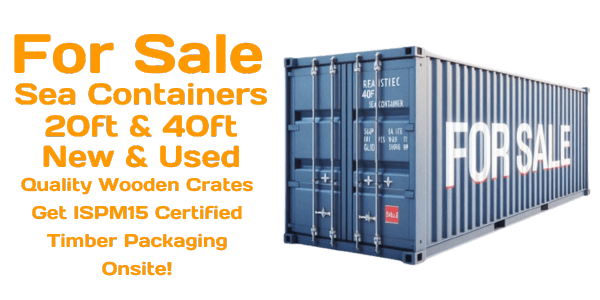About Us
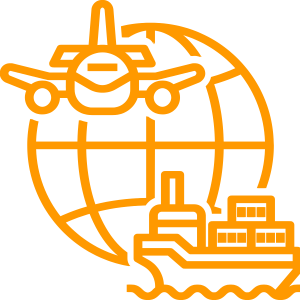 At CargoMaster, we consistently deliver low-cost freight forwarding solutions designed to meet your global shipping needs. Through effective air and sea freight import and export processes, we streamline operations, ensuring complete control of your shipment from origin to destination. By minimizing unnecessary handling and cutting out middle margins, we pass the savings directly to you.
At CargoMaster, we consistently deliver low-cost freight forwarding solutions designed to meet your global shipping needs. Through effective air and sea freight import and export processes, we streamline operations, ensuring complete control of your shipment from origin to destination. By minimizing unnecessary handling and cutting out middle margins, we pass the savings directly to you.
As a CargoMaster customer, you enjoy the advantages of a comprehensive, guaranteed low-cost freight forwarding service. With world-class tracking systems, efficient shipping practices, and strategic industry alliances, CargoMaster delivers unmatched reliability and value. Our extensive range of services includes: SameDay Air Freight, Overnight Air Freight, Sea Freight Forwarding, Air Freight Forwarding, Transhipment Cargo Services, Customs Clearance, Global Freight Logistics, Container Groupage, Air Freight Import Consolidation, Sea Freight Import Consolidation, Door-to-Door Transport Services, Excess Baggage, Project Management Consulting Services.
CargoMaster stands as a beacon of trust and innovation in the international shipping industry, offering seamless logistics solutions tailored to meet diverse client needs. With over 35 years of expertise, we’ve built a reputation for delivering excellence in freight forwarding services, catering to businesses, families, and individuals worldwide. Whether shipping personal belongings or managing large-scale commercial logistics projects, CargoMaster combines industry knowledge with cutting-edge technology to ensure every shipment reaches its destination safely and on time.
At CargoMaster, our commitment to customer satisfaction is unwavering. Our team’s dedication to professionalism and meticulous attention to detail ensures every shipment, regardless of size or complexity, is handled with care and precision. By leveraging a vast network of international freight forwarders and strategic partnerships, CargoMaster offers a one-stop solution for global shipping needs. Whether you require air freight, sea freight, or specialized logistics services, CargoMaster guarantees efficiency, reliability, and affordability.
Sea Freight
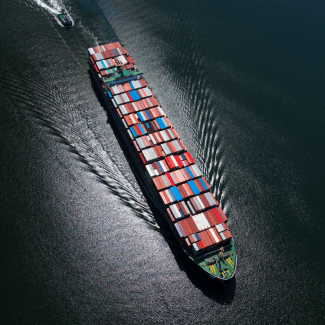
CargoMaster’s sea freight services are designed to simplify global shipping for businesses and individuals alike. With extensive experience in handling all types of cargo, from small personal shipments to heavy industrial machinery, CargoMaster provides cost-effective and reliable solutions. Leveraging a vast network of international shipping routes and trusted partnerships, CargoMaster ensures smooth transportation to destinations across the globe.
For businesses seeking bulk shipping options, CargoMaster offers full container load (FCL) and less-than-container load (LCL) services, catering to shipments of varying sizes. Specialized containers, such as refrigerated units for perishables or open-top containers for oversized items, are available to meet unique shipping requirements. The team’s expertise in documentation, customs compliance, and logistics coordination guarantees a hassle-free shipping process from start to finish.
CargoMaster’s sea freight services are backed by cutting-edge tracking technology and real-time updates, providing clients with full visibility and peace of mind. Whether you’re relocating overseas or managing a commercial shipment, CargoMaster is equipped to handle your needs with professionalism and efficiency. Trust CargoMaster to deliver your cargo safely, affordably, and on time.
20ft and 40ft Containers
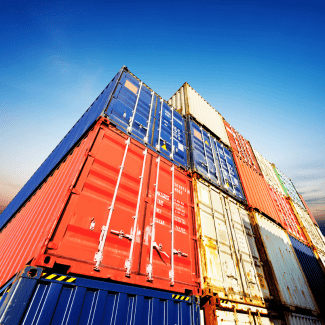
When it comes to shipping versatility and security, CargoMaster’s 20ft and 40ft containers are the ideal choice. Designed to accommodate a wide range of cargo types, these containers offer a reliable and durable solution for transporting goods across international waters. Whether you’re relocating personal belongings or managing large-scale commercial shipments, CargoMaster’s containers provide the space and protection you need.
The 20ft containers are perfect for smaller shipments, offering a compact yet spacious option for personal effects or business goods. For larger consignments, the 40ft containers double the capacity, making them ideal for bulkier items or high-volume shipments. CargoMaster also provides specialized container options, including high cube containers for extra height and open-top units for irregularly shaped cargo.
CargoMaster’s team ensures that every container is handled with care, from delivery to your location for packing to safe transportation and customs clearance. With a focus on efficiency and reliability, CargoMaster makes container shipping a seamless and stress-free process. Contact CargoMaster today to learn more about container options and start your shipping journey with confidence.
International Shipping Container Dimensions
| Type of Container | Inside Dimensions (m) | Door Opening (m) | Tare Weight (kgs) | Volume (cbm) | Loading Capacity (kgs) |
| 20′ Standard Container | 5.92×2.34×2.38 | 2.29×2.28 | 1.9 | 33 | 22.1 |
| 20′ Open Top Container | 5.92×2.34×2.38 | 2.29×2.28 | 2.177 | 31.6 | 21.823 |
| 20′ Reefer Container | 5.38×2.24×2.29 | 2.24×2.12 | 3.209 | 24.1 | 17.111 |
| 20′ Flatrack | 5.94×2.40×2.27 | 2.56 | 21.44 | ||
| 40′ Standard Container | 12.06×2.35×2.38 | 2.29×2.28 | 3.107 | 67.3 | 27.373 |
| 40′ Open Top Container | 12.064×2.34×2.37 | 2.29×2.25 | 4.445 | 64 | 26.067 |
| 40′ Reefer Container | 11.21×2.25×2.18 | 2.22×2.12 | 4.84 | 49.3 | 25.64 |
| 40′ Flatrack | 12.07×2.42×2.10 | 5.55 | 25.22 | ||
| 40′ High-Cube | 12.06×2.34×2.68 | 2.29×2.25 | 3.265 | 75.8 | 27.215 |
Self-Pack Containers
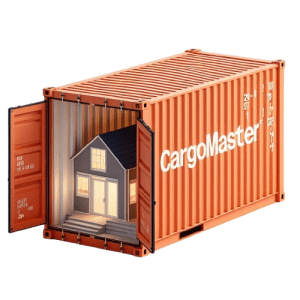
For clients seeking flexibility and cost-effectiveness, CargoMaster’s self-pack containers offer the perfect solution. These containers are delivered directly to your location, allowing you to pack your items at your own pace. This user-friendly approach ensures that your belongings are carefully prepared for transit, providing convenience and control over the packing process.
CargoMaster offers a range of container sizes, including 20ft and 40ft options, as well as high cube and open-top containers for specialized cargo. The team provides expert guidance on packing techniques to maximize space and ensure the safety of your goods. Once packed, CargoMaster manages the logistics, from pickup and transportation to customs clearance and final delivery, ensuring a smooth and efficient shipping experience.
Choosing CargoMaster’s self-pack containers means benefiting from personalized support and professional expertise at an affordable price. Whether you’re relocating overseas or managing commercial shipments, CargoMaster’s self-pack services provide peace of mind and reliability every step of the way.
Specialized Freight Services & Break Bulk

CargoMaster excels in managing complex logistics scenarios with its specialized freight services and break bulk solutions. Ideal for oversized or non-containerized cargo, such as industrial equipment or construction materials, these services cater to unique shipping requirements. With decades of experience, CargoMaster handles challenging freight operations with precision and professionalism.
The team at CargoMaster works closely with clients to develop tailored solutions, from heavy-lift operations to the transportation of irregularly shaped goods. Advanced equipment and innovative handling techniques ensure the safe and efficient transit of every shipment. From port operations to inland transportation, CargoMaster coordinates every detail, providing a seamless logistics experience.
For businesses managing large-scale projects or navigating intricate logistics challenges, CargoMaster’s specialized freight services offer the expertise and reliability needed to succeed. Contact CargoMaster today to explore customized shipping solutions that meet your specific needs and exceed expectations.
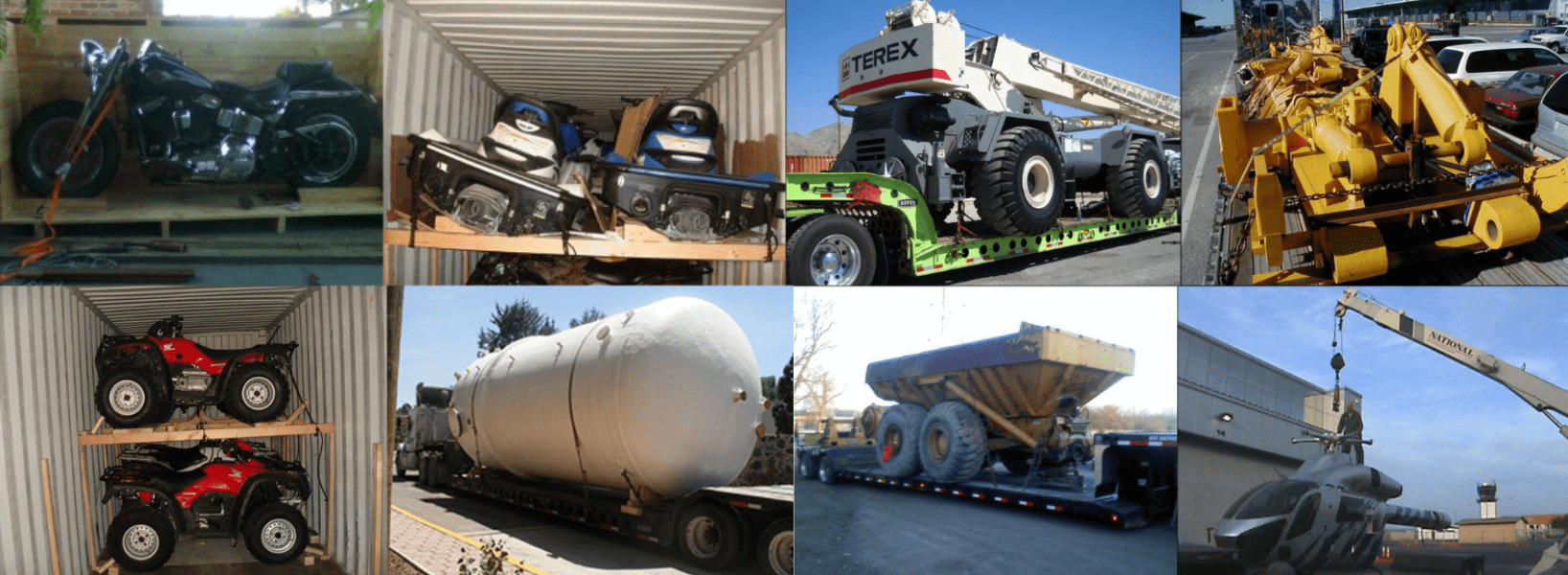
Customs Clearance
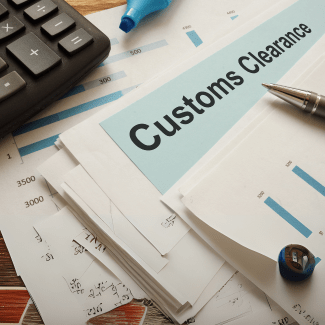
Navigating international customs regulations can be complex, but CargoMaster’s customs clearance services simplify the process. With a team of experienced professionals, CargoMaster manages all aspects of documentation, compliance checks, and communication with customs authorities, ensuring efficient clearance and minimizing delays.
CargoMaster’s deep understanding of international shipping regulations allows the team to handle duties, taxes, and potential compliance issues with ease. By streamlining the customs process, CargoMaster ensures that shipments arrive at their destination on time and without unnecessary complications. Close relationships with customs officials further expedite the process, providing clients with added assurance.
For businesses and individuals shipping to international destinations, CargoMaster’s customs clearance services offer peace of mind and efficiency. Let CargoMaster handle the complexities of international logistics so you can focus on what matters most. Contact CargoMaster today for expert customs support and seamless shipping solutions.
Frequently Asked Questions
What is sea freight?
Sea freight, also known as international sea freight, is a long-established method of global transportation. It offers a cost-effective solution for moving both large and small shipments across borders. Most sea freight is transported in 20ft and 40ft containers aboard cargo vessels. Once packed, containers are loaded onto ships and delivered to their destination.
Modern cargo vessels typically carry around 15,000 containers, with some accommodating as many as 24,000.
There are several ways to transport goods via sea freight
- Full Container Load (FCL) is the most widely used and economical method. A dedicated container is provided for your cargo, which is returned upon arrival at its destination. FCL offers the best cost efficiency per cubic meter for general shipments.
- Less than Container Load (LCL) is an option for smaller shipments, where cargo is combined with other goods in shared containers heading to the same destination. Pricing is based on volume or weight, whichever is greater. LCL shipments generally take longer due to additional handling and consolidation.
- Break Bulk Shipping is reserved for oversized or heavy cargo that cannot fit into standard containers. Industrial machinery and mining equipment are common examples of break bulk freight.
- Vessel Charter and Bulk Shipments are used for exporting large-scale commodities such as coal, iron ore, sugar, and grain.
What are the benefits of international shipping?
International shipping offers several advantages
- Cost-efficiency—Compared to air freight, sea freight is a more affordable option for shipments exceeding 100kg or consisting of multiple packages.
- Environmental sustainability—Sea freight has a lower carbon footprint than other transportation methods, making it an eco-conscious choice.
- Capacity for large cargo—Oversized, heavy, or uniquely shaped goods can be easily transported by sea due to cargo ships’ expansive storage capabilities.
- Fewer restrictions—Unlike air freight, which is highly regulated, sea freight accommodates a broader range of cargo with fewer limitations, including hazardous materials.
How long does sea freight take?
Transit times depend on the shipping route and final destination. Direct vessel services provide faster deliveries, while transshipment—the process of transferring cargo between ships—can extend travel times.
Why are freight rates from China so high?
Sea freight rates from China remain competitive. However, CargoMaster does not handle shipping services from China.
Why are freight costs increasing?
Freight rates fluctuate over time due to multiple factors, including rising fuel prices, increased global demand, and currency exchange rates.
What is sea freight?
Sea freight refers to goods transported across international and domestic waters via cargo vessels. It is the oldest form of global trade and is typically used for shipments that do not require expedited air transport.
Why use sea freight?
Sea freight is ideal for businesses and traders operating internationally, particularly when moving large shipments that do not require urgent delivery. It is also a cost-effective alternative to air freight.
How does sea freight work?
Shipping containers—primarily 20ft or 40ft in size—are commonly used for transporting goods. Containers can be delivered to the shipper for packing or loaded at specialized cargo facilities. Once packed, they are collected and transferred onto vessels bound for their destination.
Is sea freight cheaper than air freight?
Sea freight is more affordable than air freight, though it requires longer transit times and additional handling. Air freight is better suited for urgent, fragile, or high-value goods.
How much does sea freight cost?
Pricing depends on various factors, including shipment origin and destination, cargo size and weight, and the method of transportation chosen.
Why is sea freight so expensive?
Several elements contribute to fluctuations in sea freight pricing, such as increased shipment volumes, rising fuel costs, and currency exchange rate changes.
How long does it take to ship a container to the UK?
Transit time from Australia to the UK averages around 35 days, depending on the shipping carrier. CargoMaster provides weekly services to major UK ports, including Tilbury, Southampton, and Felixstowe.
What is the approximate transit time when shipping from Australia to the USA?
CargoMaster can secure shipments to the USA in as little as 35 days, depending on the final port destination.
Why should I use CargoMaster for my sea freight from Australia?
CargoMaster brings over 35 years of industry expertise, ensuring safe, efficient, and reliable cargo transportation. Trusted professionals handle every shipment with care, avoiding the risks posed by misleading low-cost freight providers. Choosing CargoMaster guarantees experienced service from professionals who understand the complexities of international shipping.
CargoMaster Shipping Destinations: Fiji, Tonga, Solomon Islands, The Federated States of Micronesia, New Zealand, Canada, Africa
(Click the +/- plus/minus symbols to expand/collapse)
SEA FREIGHT SHIPPING LINES
- ACL Atlantic Container Line
- Alianca Navegaceo e Logistica Ltda.
- ANL Container Line
- APL American President Line
- ARKAS LINE
- Bahr
- CCNI
- CSCL CHINA SHIPPING CONTAINER LINES
- CMA-CGM
- CNC LINE Cheng Lie Navigation
- COSCO CONTAINER LINES
- COSCO USA
- COSCO Canada
- CP SHIPS
- CROWLEY
- CSAV
- CSAV Norasia
- DAL – Deutsche Afrika Linien
- DELMAS
- EIMSKIP
- Emirates Shipping Line
- Evergreen Lines
- FESCO
- Gold Star Line
- Grieg Star Shipping
- Grimaldi Lines
- Hamburg-Sued (Columbus Line)
- Hanjin
- Hapag-Lloyd
- HAWK CONTAINER LINES
- HEUNG A Shipping
- HORIZON Lines
- HUBLine
- HUGO STINNES
- HYUNDAI Merchant Marine (HMM)
- Ignazio Messina Line
- INTERASIA Lines
- Italia Marittima
- Kambara Kisen
- Kestrel Liner
- KMTC Line
- LIBRA
- MACS Shipping
- Maersk Line
- MARFRET Compagnie Maritime
- MAXICON Container Line
- MOL Mitsui OSK Lines
- MSC
- NSCSA National Shipping Company of Saudi Arabia
- Nordana
- NYK Nippon Yusen Kaisha Lines
- Ocean Empire Lines
- OOCL
- PDL Pacific Direct Line
- PIL Pacific International Lines
- POLLUX & CASTOR
- RCL Regional Container Lines
- Royal Arctic Lines
- Safmarine
- SCI Shipping Corporation of India
- Seaboard Marine
- Seago Line
- Sea Star Line
- Sinokor
- Sofrana
- STX PanOcean
- Swire Shipping
- Tarros
- TCC The Containership Company
- T.S. Lines
- TRANSLINER
- UASC United Arab Shipping Co
- Wan Hai Lines
- W.E.C. Lines
- WESTWOOD SHIPPING LINES
- Yang Ming
- Zim Line
SEA FREIGHT CONTAINER SIZE OPTIONS
| Type of Container | Inside Dimensions (m) | Door Opening (m) | Tare Weight (kgs) | Volume (cbm) | Loading Capacity (kgs) |
|---|---|---|---|---|---|
| 20' Standard Container | 5.92x2.34x2.38 | 2.29x2.28 | 1.9 | 33 | 22.1 |
| 20' Open Top Container | 5.92x2.34x2.38 | 2.29x2.28 | 2.177 | 31.6 | 21.823 |
| 20' Reefer Container | 5.38x2.24x2.29 | 2.24x2.12 | 3.209 | 24.1 | 17.111 |
| 20' Flatrack | 5.94x2.40x2.27 | 2.56 | 21.44 | ||
| 40' Standard Container | 12.06x2.35x2.38 | 2.29x2.28 | 3.107 | 67.3 | 27.373 |
| 40' Open Top Container | 12.064x2.34x2.37 | 2.29x2.25 | 4.445 | 64 | 26.067 |
| 40' Reefer Container | 11.21x2.25x2.18 | 2.22x2.12 | 4.84 | 49.3 | 25.64 |
| 40' Flatrack | 12.07x2.42x2.10 | 5.55 | 25.22 | ||
| 40' High-Cube | 12.06x2.34x2.68 | 2.29x2.25 | 3.265 | 75.8 | 27.215 |
SHIPPING CONTAINER DIMENSIONS
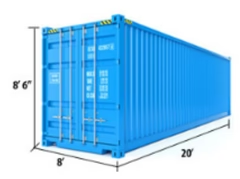 20 ft Standard Dry (8'6" x 8' x 20')
20 ft Standard Dry (8'6" x 8' x 20')
Weight: 4500lbs
Max Gross Weight: 66,139lbs
Interior Dimensions:
Length: 19′ 5″
Width: 7′ 8-⅛”
Height: 7′ 9-⅝”
Door Opening:
Width: 7’ 8-½”, Height: 7’ 5-¾”
40 ft Standard Dry (8'6" x 8' x 40')
Weight: 8500lbs
Max Gross Weight: 66,139lbs
Interior Dimensions:
Length: 39′ ⅜”
Width: 7′ 8-⅛”
Height: 7′ 9-⅝”
Door Opening:
Width: 7’ 8-½”, Height: 7’ 5-¾”
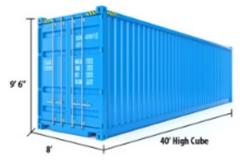 40 ft High Cube (9'6" x 8' x 40')
40 ft High Cube (9'6" x 8' x 40')
Weight: 8750 lbs
Max Gross Weight: 68,008lb
Interior Dimensions:
Length: 39′ 4”
Width: 7′ 7”
Height: 8′ 9″
Door Opening: Width:
7’ 8″‘, Height: 8’ 5”
 Dimensions of 20ft Flat Rack Container
Dimensions of 20ft Flat Rack Container
Internal length 5.94 m / 19.5 ft
Internal width 2.35 m / 7.7 ft
Internal height 2.35 m / 7.7 ft
Tare weight 2,360 kg / 5,203.8 lbs
Payload capacity: 30,140 kg / 66,458.7 lbs
Cubic capacity 32.7 m³ / 1,154.3 cu ft
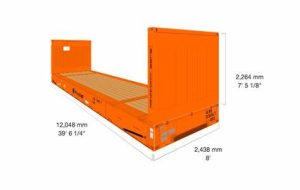 Dimensions of 40ft Flat Rack Container
Dimensions of 40ft Flat Rack Container
Internal length 12.13 m / 39.8 ft
Internal width 2.40 m / 7.9 ft
Internal height 2.14 m / 7 ft
Tare weight 5,000 kg / 11,025 lbs
Payload capacity: 40,000 kg / 88,200 lbs
Cubic capacity 62.2 m³ / 2,195.7 cu ft
HIDDEN DANGEROUS AIR CARGO
Please Note: The below list does not describe all types of hazardous air cargo (it is not exhaustive and all encompassing). General items listed below may be found in baggage and possibly have hazards that are not immediately apparent. There are strict laws in relation to lodging of hazardous air cargo and compliance with hazardous air cargo regulations.
Typical examples of hazardous air cargo
Engines (contain fuel and that are not cleaned, purged and sealed)
Mining equipment
Magnets
Pressurised containers
Passenger baggage (containing flammable gas or liquid lighter refuel. camping stove cylinders
Photographic Supplies
Expeditionary equipment
Vaccines
Solvents, adhesives
Pesticides
Dental apparatus
Machinery parts
Frozen foods (packed in solid dry ice)
Dry Ice
Tool Boxes (compressed gases, aerosols)
Electrical equipment
Diving equipment
Pharmaceuticals
Switches in electrical equipment
Toys (made of cellulose)
Refrigerators (may contain gases or chemicals)
Swimming pool chemicals
Pressurised containers
Engines (contain fuel and that are not cleaned, purged and sealed)
Mining equipment
Diagnostic specimens
Thermometers (containing mercury)
Frozen Embryos
Ammunition
Swimming pool chemicals
Aerosols
Compressed non-flammable gas
Batteries
Breathing Apparatus
Frozen foods (packed in solid dry ice)
Motor Vehicle parts
Chemicals
HAZARD LABELS FOR DANGEROUS GOODS (DG)
Hazard Labels for Dangerous Goods (DG)
The international community has established a classification system for easy identification of dangerous goods. These goods fall into nine primary classes, and some classes are further divided to address specific risks. Each class/division has a corresponding label that accurately represents the nature of the hazard. These labels must be attached to the package during transport and remain intact throughout the journey. Take a look at the illustrated examples below to understand how these labels effectively communicate the potential dangers.
Under regulations, labels must be clearly visible on the outside of the package and must stay on the package while in transit.
You can often find labels printed on most inner packages such as:
- aerosol cans
- bottles of bleach
- containers of thinners
- tins of paint
- many other products which are available at supermarkets and hardware stores.
Below are the 9 hazard labels for the 9 classes of dangerous goods.
Class 1 Explosives

This includes items such as:
- explosive substances
- pyrotechnic devices
- ammunition
- fireworks
- detonators.
Class 2 Gases

These can be transported as:
- compressed
- liquefied
- refrigerated liquefied
- gas in solution.
This includes aerosols. Class 2 has 3 divisions:
- Division 2.1 - flammable gases such as:
- butane
- propane
- Division 2.2 - non-flammable, non-toxic gases such as:
- oxygen
- liquid nitrogen
- compressed air
- Division 2.3 - toxic gases such as:
- chlorine
- hydrogen sulphide.
Class 3 Flammable liquids

This includes liquids with a boiling point of 35⁰ C or less, or a flash point of 60⁰ C or less such as:
- petrol
- alcohol
- perfumes
- essential oils
- hand sanitiser
- paints.
Class 4 Flammable solids

These are substances that can spontaneously combust and substances, that when they come into contact with water or emit flammable gases. Class 4 has 3 divisions:
- Division 4.1 - flammable solids such as:
- hexamine solid fuel tablets for camping stoves
- self-reactive substances
- desensitised explosives
- Division 4.2 - substances that can spontaneously combust under normal air transport conditions include:
- camphor
- sulphur
- matches
- Division 4.3 - substances that emit flammable gases when they come into contact with water include:
- sodium
- zinc particles
- activated carbon.
Class 5 Oxidising substances and organic peroxides

These substances are not necessarily combustible on their own but can react dangerously with other substances. Class 5 has 2 divisions:
- Division 5.1 - oxidising substances that may not be necessarily combustible, but they may readily yield oxygen and cause other materials to combust, such as:
- hydrogen peroxide
- ammonium nitrate
- potassium chlorate
- sodium nitrate
- Division 5.2 - organic peroxides are thermally unstable and can emit heat and give off harmful or flammable vapours. They can also be liable to explosive decomposition and react dangerously with other substances. Examples are:
- acetyl acetone peroxide
- benzoyl peroxide
- peracetic acid.
Class 6 Toxic and infectious substances

These substances can cause sickness, injury or death if consumed. Class 6 has 2 divisions:
- Division 6.1 - toxic substances that can cause death, injury or to harm human health if swallowed, inhaled or by skin contact, such as:
- chloroform
- arsenics
- cyanides
- cytotoxic waste
- barium compounds
- pesticides
- Division 6.2 - infectious substances that contain or are expected to contain pathogens that can cause disease in humans or animals, including:
- medical or clinical waste
- patient specimens
- genetically modified organisms
- infectious substances
- infected animals.
Class 7 Radioactive materials

These are substances that emit invisible ionising radiation that can be harmful to humans and animals. It can cause objects such as aircraft and equipment to become contaminated if not packaged and handled correctly, such as:
- uranium
- radioactive ores
- isotypes
- radium
- cesium
- x-ray equipment
- medical equipment or parts.
Class 8 Corrosives

These substances can cause irreversible damage if they come into contact with skin and could destroy other freight, or materially damage containers or aircraft. This includes:
- acids
- corrosive cleaners
- battery fluid
- formaldehyde
- hydrofluoric acid.
Class 9 Miscellaneous

These are substances and articles which, during air transport, present a danger not covered by other classes. There are 2 types of handling labels – 1 for lithium battery shipments, and another for all other miscellaneous dangerous goods. This class includes:
- lithium batteries
- battery powered vehicles
- battery powered equipment
- first aid kids
- environmentally hazardous substances
- dry ice
- magnetised materials
- asbestos.
Handling labels
In addition to hazard labels, trained staff must attach handling labels where needed. Staff must use these 4 handling labels with the appropriate hazard labels:
Cargo aircraft only

This label is used to show that the load cannot be carried on a passenger aircraft.
Cyrogenics

This label is used on liquefied gases, such as the ones in Class 2.
This way up

This label ensures a load is placed the correct way up and can be used for non-dangerous goods.
Magnetised material

This label ensures that the load is kept away from the aircraft compass detector unit while being loaded and unloaded.
INCOTERMS
INCOTERMS are standard trade terms most commonly used in international freight contracts for sale of goods. It is essential that you are aware of your terms of trade prior to shipment.
EXW – EX WORKS (… named place of delivery)
The Seller’s only responsibility is to make the goods available at the Seller’s premises. The Buyer bears full costs and risks of moving the goods from there to destination.
FCA – FREE CARRIER (… named place of delivery)
The Seller delivers the goods, cleared for export, to the carrier selected by the Buyer. The Seller loads the goods if the carrier pickup is at the Seller’s premises. From that point, the Buyer bears the costs and risks of moving the goods to destination.
CPT – CARRIAGE PAID TO (… named place of destination)
The Seller pays for moving the goods to destination. From the time the goods are transferred to the first carrier, the Buyer bears the risks of loss or damage.
CIP– CARRIAGE AND INSURANCE PAID TO (… named place of destination)
The Seller pays for moving the goods to destination. From the time the goods are transferred to the first carrier, the Buyer bears the risks of loss or damage. The Seller, however, purchases the cargo insurance.
DAT – DELIVERED AT TERMINAL (… named terminal at port or place of destination)
The Seller delivers when the goods, once unloaded from the arriving means of transport, are placed at the Buyer’s disposal at a named terminal at the named port or place of destination. “Terminal” includes any place, whether covered or not, such as a quay, warehouse, container yard or road, rail or air cargo terminal. The Seller bears all risks involved in bringing the goods to and unloading them at the terminal at the named port or place of destination.
DAP – DELIVERED AT PLACE (… named place of destination)
The Seller delivers when the goods are placed at the Buyer’s disposal on the arriving means of transport ready for unloading at the names place of destination. The Seller bears all risks involved in bringing the goods to the named place.
DDP – DELIVERED DUTY PAID (… named place)
The Seller delivers the goods -cleared for import – to the Buyer at destination. The Seller bears all costs and risks of moving the goods to destination, including the payment of Customs duties and taxes.
MARITIME TERMS
FAS – FREE ALONGSIDE SHIP (… named port of shipment)
The Seller delivers the goods to the origin port. From that point, the Buyer bears all costs and risks of loss or damage.
FOB– FREE ON BOARD (… named port of shipment)
The Seller delivers the goods on board the ship and clears the goods for export. From that point, the Buyer bears all costs and risks of loss or damage.
CFR– COST AND FREIGHT (… named port of destination)
The Seller clears the goods for export and pays the costs of moving the goods to destination. The Buyer bears all risks of loss or damage.
CIF – COST INSURANCE AND FREIGHT (… named port of destination)
The Seller clears the goods for export and pays the costs of moving the goods to the port of destination. The Buyer bears all risks of loss or damage. The Seller, however, purchases the cargo insurance.
SEA FREIGHT SHIPPING LINES
- ACL Atlantic Container Line
- Alianca Navegaceo e Logistica Ltda.
- ANL Container Line
- APL American President Line
- ARKAS LINE
- Bahr
- CCNI
- CSCL CHINA SHIPPING CONTAINER LINES
- CMA-CGM
- CNC LINE Cheng Lie Navigation
- COSCO CONTAINER LINES
- COSCO USA
- COSCO Canada
- CP SHIPS
- CROWLEY
- CSAV
- CSAV Norasia
- DAL – Deutsche Afrika Linien
- DELMAS
- EIMSKIP
- Emirates Shipping Line
- Evergreen Lines
- FESCO
- Gold Star Line
- Grieg Star Shipping
- Grimaldi Lines
- Hamburg-Sued (Columbus Line)
- Hanjin
- Hapag-Lloyd
- HAWK CONTAINER LINES
- HEUNG A Shipping
- HORIZON Lines
- HUBLine
- HUGO STINNES
- HYUNDAI Merchant Marine (HMM)
- Ignazio Messina Line
- INTERASIA Lines
- Italia Marittima
- Kambara Kisen
- Kestrel Liner
- KMTC Line
- LIBRA
- MACS Shipping
- Maersk Line
- MARFRET Compagnie Maritime
- MAXICON Container Line
- MOL Mitsui OSK Lines
- MSC
- NSCSA National Shipping Company of Saudi Arabia
- Nordana
- NYK Nippon Yusen Kaisha Lines
- Ocean Empire Lines
- OOCL
- PDL Pacific Direct Line
- PIL Pacific International Lines
- POLLUX & CASTOR
- RCL Regional Container Lines
- Royal Arctic Lines
- Safmarine
- SCI Shipping Corporation of India
- Seaboard Marine
- Seago Line
- Sea Star Line
- Sinokor
- Sofrana
- STX PanOcean
- Swire Shipping
- Tarros
- TCC The Containership Company
- T.S. Lines
- TRANSLINER
- UASC United Arab Shipping Co
- Wan Hai Lines
- W.E.C. Lines
- WESTWOOD SHIPPING LINES
- Yang Ming
- Zim Line
SEA FREIGHT TRACK AND TRACE
- ACL
- Alianca
- American President Lines
- ANL
- ARKAS Line
- Atlantic Container Line
- Bahri
- Bridgehead
- CAI
- Capital Lease
- Carlisle Leasing
- CCNI
- China Shipping
- CMA CGM
- CNC Line
- Columbus Line
- Cosco Canada
- COSCO Container Lines
- Crowley Liner Services
- CSAV Group
- CSVA Norasia
- DAL
- Delmas
- Dongnama
- Emirates Shipping Line
- Eric Hassell & Son
- Eucon
- Evergreen
- Florens Container Services
- GOLD
- Hamburg Sud
- Hanjin Shipping
- Hawk Container Lines
- Heung-A Shipping
- Horizon
- Hub Line
- Hyundai
- Ignazio Messina Line
- Interasia Lines
- Interpool
- IRISL
- Italia Marittima
- Kambara Kisen
- Kesterl
- K-line
- KMTC
- Korea Marine Transport
- Libra
- Lynden Tracking Center
- Maersk Line
- Marfret
- MATSON
- Mediterranean Shipping Company (MSC)
- MOL
- Namsung
- NSCSA
- NYK Line
- Ocean Empire Lines
- OOCL Shipping Line
- OTAL
- Pacific Direct Line
- PIL
- Pollux & Castor
- Regional Container Lines
- Royal Arctic
- Safmarine
- SCI
- Sea Star Line
- Seaboard Marine
- Senator Lines
- Sinokor
- SITC
- Sofrana
- Star Shipping
- STX PanOcean
- Swire Shipping
- T S Lines
- TAL International
- Tarros
- TCC The Container Company
- Textainer
- Transliner
- Triton Container
- Tropical Shipping
- UES
- United Arab Shipping
- Wallenius Wilhelmsen Shipping
- Wan Hai Lines
- Westwood Shipping Lines
- Yang Ming
- ZIM
SEA FREIGHT AGENT LOCATIONS
Africa
| Asia / Pacific
| Caribbean & Central America
|
Europe
| Middle East
| North America
South America
|
SEA FREIGHT PORTS
| Port, Country | Volume 2012 (Million TEUs) | Volume 2011 (Million TEUS) |
|---|---|---|
| Shanghai, China | 32.53 | 31.74 |
| Singapore,Singapore | 31.65 | 29.94 |
| Hong Kong, China | 23.1 | 24.38 |
| Shenzhen, China | 22.94 | 22.57 |
| Busan, South Korea | 17.04 | 16.18 |
| Ningbo-Zhoushan, China | 16.83 | 14.72 |
| Guangzhou Harbor, China | 14.74 | 14.42 |
| Qingdao, China | 14.5 | 13.02 |
| Jebel Ali, Dubai, United Arab Emirates | 13.3 | 13 |
| Tianjin, China | 12.3 | 11.59 |
| Rotterdam, Netherlands | 11.87 | 11.88 |
| Port Kelang, Malaysia | 10 | 9.6 |
| Kaohsiung, Taiwan, China | 9.78 | 9.64 |
| Hamburg, Germany | 8.86 | 9.01 |
| Antwerp, Belguim | 8.64 | 8.66 |
| Los Angeles, U.S.A. | 8.08 | 7.94 |
| Dalian, China | 8.06 | 6.4 |
| Keihin ports*, Japan | 7.85 | 7.64 |
| Tanjung Pelepas, Malaysia | 7.7 | 7.5 |
| Xiamen, China | 7.2 | 6.47 |
| Bremen/Bremerhaven, Germany | 6.12 | 5.92 |
| Tanjung Priok, Jakarta, Indonesia | 6.1 | 5.62 |
| Long Beach, U.S.A. | 6.05 | 6.06 |
| Laem Chabang, Thailand | 5.93 | 5.73 |
| New York-New Jersey, U.S.A. | 5.53 | 5.5 |
| Ho Chi Minh, Vietnam | 5.19 | 4.53 |
| Lianyungung, China | 5.02 | 4.85 |
| Hanshin* ports, Japan | 5 | 4.8 |
| Yingkou, China | 4.85 | 4.03 |
| Jeddah, Saudi Arabia | 4.74 | 4.01 |
| Valencia, Spain | 4.47 | 4.33 |
| Columbo, Sri Lanka | 4.26 | 4.26 |
| Jawaharlal Nehru, India | 4.26 | 4.32 |
| Algerciras Bay, Spain | 4.07 | 3.6 |
| Sharjah, United Arab Emirates | 4 | 3.23 |
| Felixstowe, U.K. | 3.95 | 3.74 |
| Port Said, Egypt | 3.91 | 3.91 |
| Manila, Philippines | 3.71 | 3.46 |
| Salalah, Oman | 3.63 | 3.2 |
| Colon, Panama | 3.52 | 3.37 |
| Balboa, Panama | 3.3 | 3.23 |
| Santos, Brazil | 3.17 | 2.99 |
| Ambarli, Turkey | 3.1 | 2.69 |
| Georgia Ports, U.S.A. | 2.97 | 2.94 |
| Nagoya, Japan | 2.87 | 2.62 |
| Tanjung Perak, Surabaya, Indonesia | 2.85 | 2.64 |
| Gioia Tauro, Italy | 2.72 | 2.3 |
| Metro Vancouver, Canada | 2.71 | 2.51 |
| Melbourne, Australia | 2.6 | 2.51 |
| Durban, South Africa | 2.59 | 2.71 |
International Freight Routes
Thank-you for contacting us, it’s great that you have selected our contact us page, we appreciate the opportunity, if your shipment relates to air freight or less than a container load sea freight, please include the weight and dimensions of each piece in your request. We look forward to working with you, please feel free to call at any time.
TEL: 1300 767 136

